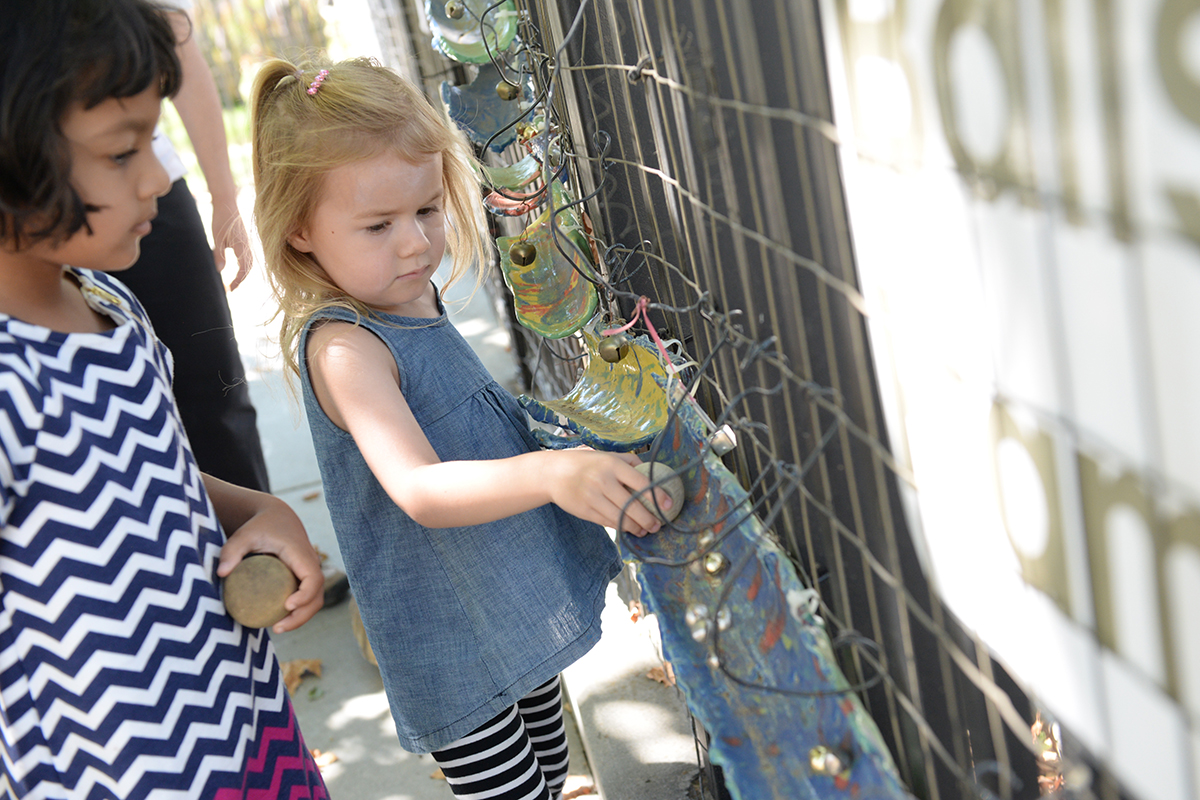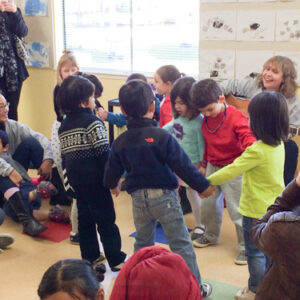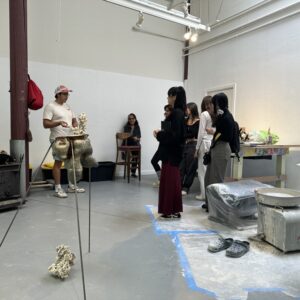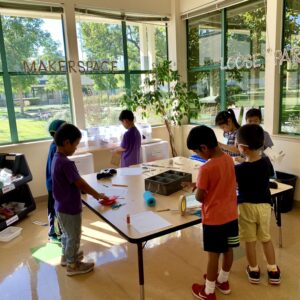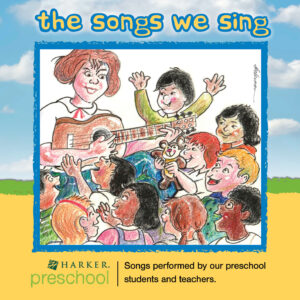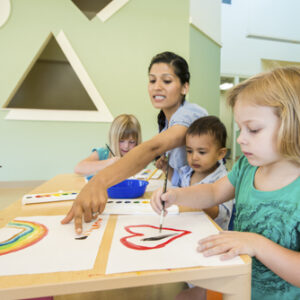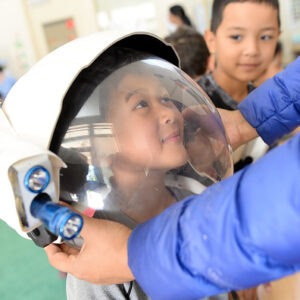This article originally appeared in the winter 2016 Harker Magazine.
Editor’s Note: This project took place in the 2015-16 school year; students are identified by the ages they were at the time.
For several weeks, Alex Micchelli, a 5-year-old transitional kindergarten student at Harker Preschool, kept returning to the clay table, engrossed in making ball ramps. One day Alexandria Kerekez, the preschool’s visual arts specialist, sat down next to him and asked him what his goal was in making the clay ramps.
As Alex gingerly held his tiny clay ball, he explained in one of those magic moments teachers love to have, “I want the ball to roll down the sculpture like at STEM lab.” Art had met science and it was good!
Along with plenty of indoor and outdoor play time, Harker Preschool has three specialized areas of development: STEM, visual arts, and music & movement. These specialty classes are rich with activity centers and educational materials, offering a balance between child-directed exploratory learning and teacher directed activities.
Alex had been captivated by the physics of things that roll since starting at Harker Preschool as a 3-year-old. He worked with ramps and balls – measuring the slope of ramps and the distance the balls traveled – and wanted to build a permanent pathway that he could take home and share with his family. He ended up creating a project that engrossed many other preschoolers, noted Robyn Stone, STEM specialist.
During a subsequent art session, children excitedly experimented with Alex’s ball ramp design. A variety of prototypes began to emerge, noted Kerekez. Teams of children collaborated on different strategies to form the ball ramps. The young students debated whether ramps should have a “flat slab” base or a “single coil” base, each a method of stabilizing an object with an irregular bottom, noted Kerekez. As the projects progressed, the effort drew the class together, with groups of students joining forces to create a communal twisting, turning ball ramp.
To extend the interest in the ball ramp project, Kerekez, Stone, and music & movement specialist Mara Beckerman joined together to invite the transitional kindergarten students to create a larger musical ball ramp system out of clay for the Farm, the outdoor area of the preschool dedicated to plants and animals.
Students shaped ramp sections, which were glazed and fired, then fastened piece by piece to a fence in the Farm to create the full ramp. The children were entranced when they discovered that glass marbles created a symphony of tones as they ricocheted down the ceramic tracks. “Listen! It makes music!” exclaimed Nathan Zhang, age 3. That was just the beginning.
The tinkling of the balls down the ramp was a revelation to the children, and they immediately wanted to enhance the sound. “Let’s put a violin on it!” suggested Sophie Crosswhite, age 4, reaching for the sky. Realizing that mounting a violin above the ramp was impractical, the children began experimenting with smaller objects.
During their music & movement sessions, the children tested nails and washers as music makers, suspending them over the ramp so the rolling ball tapped them as it passed. The children noted the items were too heavy, preventing the balls from continuing down the ramp, and they lacked musical tone. “I can’t hear anything” was the general, disappointed response, when asked to listen to the ball hitting the bits of hardware.
However, Beckerman was ready with little jingle bells from a craft store. These produced a highly satisfactory sound as the balls tapped them in passing.
With the ramp complete, and a ball poised at the top to make a trial run, 3-year-old Jacob Shimelfarb’s eyes widened and he released the ball. Zipping down the ramp, the ball rolled under a bridge, ringing bells along the way. The ball passed through a tunnel and leaped off the curved end of the ramp into a basket. “Wow!” exclaimed Jacob.
Other students were equally impressed. “It’s like little fairies in the farm!” said Emmabelle White, age 4, when she heard the bells ting-a-ling. The musical results prompted the preschool kids and staff to refer to this project as “singing” ball ramps.
In the STEM lab, all Harker preschoolers have the opportunity to freely conduct experiments in the physical sciences, noted Stone. “Exploring various materials in a self-directed way enables a child to discover the properties of objects and the physics of motion,” she added. Stone supports the children’s explorations by asking questions to engage them and help them become familiar with the academic language that describes the phenomena observed.
The mechanics of setting up the track was one of the challenges transitional kindergarten students faced, and a number of skills were acquired as the project developed, Kerekez noted. The children chose the glazes and learned about the firing process, then had to make the segments work together. Students hung the segments along the fence and suspended the noisemakers above the ramp, just close enough to be hit by the rolling ball. These were all fairly complex efforts for 5-year-olds.
At every stage of this project, noted Kerekez, one constant was the enthusiasm for sharing ideas and problem-solving as a group. Before installing the ramps on the fence, the students built prototypes in the art studio to test their ideas. They folded paper ramps into varying slopes to test how the balls would roll. The students agreed the ramps would have to be installed one at a time, at different angles, for the project to be successful. Constructing the ramp was a very collaborative effort, Kerekez observed.
The enhancements added another interesting dimension. To suspend the bells at just the right points above the ramp, “the children learned to wrap wire with their fingers and needle-nose pliers,” said Beckerman. “Once attached, the children ran tests to make sure each bell was positioned in the correct spot for the ball to tap it and keep rolling.”
Finally, after observing the completed, “singing” ball ramp in action, it was time for some theorizing. Like true physicists, they made observations and shared their findings.
Srikrishna Kataru, age 5, observed that the ball “rolls ’cause the air pushes it. If there is a lot of air, the ball will roll fast.” Overhearing the discussion, Hemansh Gupta, age 5, noted, “It is the slide that makes it go, like when I bike down a hill, and it goes very fast.”
Thinking beyond ceramic balls, Cynthia Zhang, age 5, noted, “This ball track is for a roly poly [pill bug] to slide on it on the Farm.”
Ethan Yu, age 5, added, “Yes, but you have to make a rectangle slab and bend it here at the bottom, or else the bug will fall out.”
Returning to the STEM lab each week, year after year, children repeat investigations to deepen their understanding of how objects move. They are encouraged to wonder about the physical causes and effects at play – momentum, friction, force, acceleration and much more. They make observations that then inspire new questions and experiments, which sometimes lead to innovation, noted Stone.
For example, transitional kindergarten student Benjamin Kim grasped the essential element of gravity at work.He explained to his peers, “Ball tracks are like a waterfall and the balls are the water and they can fall down.”
The ball ramp project, driven by science, created using art and enhanced with music, is a great example of how the three specialty teachers joined forces to enhance learning through exploration. The ramps are aesthetically beautiful, make harmonious sounds, and engage students in a truly unique STEM experience.
The project is now in place at the preschool, and visitors delight in rolling balls down this student-made, musical, whimsically glazed ceramic ball ramp. Future generations of Harker Preschool students have the 2015-16 transitional kindergarten class to thank for the beautiful project, which surely will bring joy to the community for years to come.
Mara Beckerman, Alexandria Kerekez & Robyn Stone are the music, art and STEM specialists at Harker Preschool.
